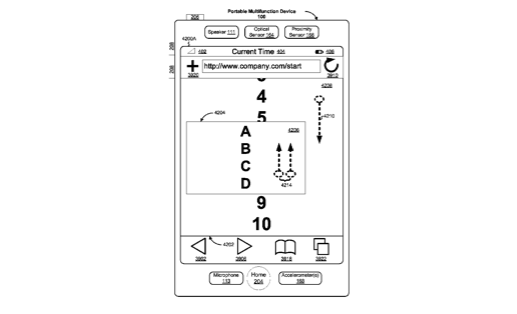In wireless lawsuit fray, Apple snags mobile touchscreen patent

Score one for Cupertino.
As computer maker Apple battles several patent-related lawsuits with Nokia, Samsung and other competitors related to the wireless functionality of its popular iPhone, iPod and iPad products, the company was awarded a patent on Tuesday involving how a user interacts with a mobile device's touchscreen display.
The abstract reads:
A computer-implemented method, for use in conjunction with a portable multifunction device with a touch screen display, comprises displaying a portion of page content, including a frame displaying a portion of frame content and also including other content of the page, on the touch screen display. An N-finger translation gesture is detected on or near the touch screen display. In response, the page content, including the displayed portion of the frame content and the other content of the page, is translated to display a new portion of page content on the touch screen display. An M-finger translation gesture is detected on or near the touch screen display, where M is a different number than N. In response, the frame content is translated to display a new portion of frame content on the touch screen display, without translating the other content of the page.
In a nutshell: it's a broad patent that covers any time a device's software responds to a user's gesture on a touchscreen, be it its operating system or a web browser. It's actually much narrower than I originally thought. As reader ralanburnett and Nilay Patel both point out, the detail is in the claims.
The company filed for it way back in 2007.
It's hard to say what the future legal implications of this patent will be, but it's clear that there is tremendous shakeout underway in the wireless device space as the tech industry's biggest giants spar over broad patents that cover nearly every operational aspect of this decade's most popular electronic devices.
Previously, Nokia accused Apple in October 2009 of infringing on its patents that cover a mobile device's ability to operate on GSM, Wi-Fi and 3G broadband networks, as well as the encryption methods used to do so.
In December 2009, Apple filed a countersuit accusing Nokia of violating 13 of its own patents. (The companies agreed last week to a patent-licensing deal; estimates for the payout run to $600 million.)
That's not all. Samsung filed a patent-infringement case against Apple in April accusing Apple of violating 10 of its patents, among them one that allows smartphone users to browse the Web during a voice call.
As you may have guessed, Apple filed its own lawsuit the same month accusing Samsung of violating patents regarding its user interface and product design.
Meanwhile, more legal briefs are flying elsewhere in the industry: Oracle and Google are beating each other up over the latter's use of Java in its Android mobile operating system; what's more, the same companies licking their legal wounds from one fight will bid next week over Nortel's wireless communications patent portfolio to perhaps pick more fights down the road.
All of these companies are sitting on enough cash to settle these patent cases. The question is whether they're spending just as much in R&D to innovate and move on.
